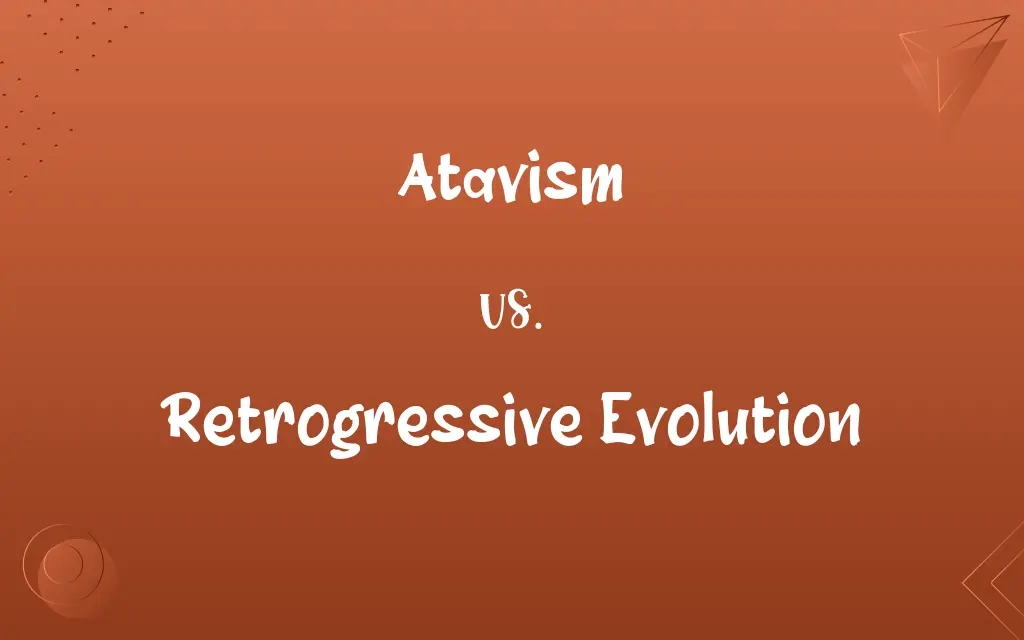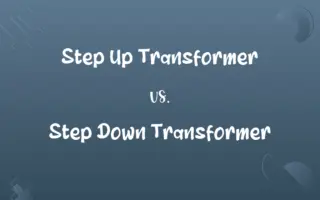Atavism vs. Retrogressive Evolution: Know the Difference

By Shumaila Saeed & Hifza Nasir || Published on October 5, 2024
Atavism refers to the reappearance of ancestral traits, while retrogressive evolution involves species simplifying or losing complex features over time.

Key Differences
Atavism and retrogressive evolution both delve into biological changes, yet they stem from different processes. Atavism surfaces when genetic traits, absent in recent generations, reemerge, showcasing the genetic blueprint's depth. Conversely, retrogressive evolution marks a species' simplification or loss of traits, driven by environmental adaptations or survival strategies, highlighting nature's dynamic equilibrium.
Shumaila Saeed
Oct 05, 2024
Atavism unexpectedly brings ancient traits to the present, retrogressive evolution reflects a deliberate adaptation process. For instance, atavistic traits like extra fingers or ancestral dental patterns in humans are sporadic and not indicative of current environmental pressures. In contrast, retrogressive evolution, such as the simplification of parasitic species losing unused organs, demonstrates an ongoing adaptation to specific niches.
Hifza Nasir
Oct 05, 2024
The mechanisms triggering atavism and retrogressive evolution differ significantly. Atavism is largely a genetic phenomenon, where dormant genes get reactivated. Retrogressive evolution, however, often results from evolutionary pressures, where less complexity offers a survival advantage.
Hifza Nasir
Oct 05, 2024
Atavism connects organisms to their past, revealing the latent potential within their genome, while retrogressive evolution showcases the pragmatic aspect of evolution—shedding unnecessary complexities for survival. This contrast underscores the diverse strategies life employs to thrive across epochs.
Shumaila Saeed
Oct 05, 2024
Understanding atavism and retrogressive evolution offers insights into the fluidity of genetic expression and evolutionary strategies. Atavism underscores the persistence of ancestral genes, whereas retrogressive evolution exemplifies the efficiency of adaptation, making both concepts pivotal in decoding life's evolutionary tapestry.
Dua Fatima
Oct 05, 2024
ADVERTISEMENT
Comparison Chart
Definition
Reappearance of ancestral traits in an organism.
Evolutionary process reducing complexity in species.
Hifza Nasir
Oct 05, 2024
Cause
Genetic reactivation of dormant traits.
Evolutionary pressures leading to simplification.
Shumaila Saeed
Oct 05, 2024
Examples
Extra fingers in humans; tail in humans.
Cave fish losing eyesight; parasites losing organs.
Hifza Nasir
Oct 05, 2024
Implication for Evolution
Highlights genetic diversity and depth.
Indicates adaptation to specific environments.
Shumaila Saeed
Oct 05, 2024
Mechanism
Sporadic and unpredictable genetic expression.
Deliberate adaptation to environmental pressures.
Shumaila Saeed
Oct 05, 2024
ADVERTISEMENT
Atavism and Retrogressive Evolution Definitions
Atavism
Manifestation of primitive features not seen in generations.
The reappearance of dense body hair is an atavistic trait.
Hifza Nasir
Feb 26, 2024
Retrogressive Evolution
Simplification of organisms over generations.
Parasites losing digestive systems reflects retrogressive evolution.
Shumaila Saeed
Feb 26, 2024
Atavism
Sporadic expression of dormant genes.
Individuals displaying webbed fingers exhibit atavism.
Shumaila Saeed
Feb 26, 2024
Retrogressive Evolution
Adaptation leading to reduced anatomical complexity.
Snakes losing their limbs through retrogressive evolution.
Hifza Nasir
Feb 26, 2024
Atavism
Genetic throwbacks to earlier evolutionary stages.
The occurrence of extra nipples in humans reflects atavism.
Hifza Nasir
Feb 26, 2024
ADVERTISEMENT
Retrogressive Evolution
Process of degeneration in response to environmental changes.
The reduction of the human appendix size is influenced by retrogressive evolution.
Dua Fatima
Feb 26, 2024
Atavism
Reappearance of ancestral physical traits.
A human born with a tail is an example of atavism.
Shumaila Saeed
Feb 26, 2024
Retrogressive Evolution
Evolutionary loss of complex features for efficiency.
Cave-dwelling fish losing eyesight is an example of retrogressive evolution.
Hifza Nasir
Feb 26, 2024
Atavism
Unpredictable reemergence of ancient characteristics.
The presence of a vestigial tailbone in humans is an atavistic feature.
Shumaila Saeed
Feb 26, 2024
Retrogressive Evolution
Species evolving simpler forms for survival.
Insects losing wings in windless environments show retrogressive evolution.
Shumaila Saeed
Feb 26, 2024
Atavism
The reappearance of an ancestral characteristic in an organism after several generations of absence; a throwback.
Shumaila Saeed
Jan 25, 2024
Atavism
The reappearance of a characteristic in an organism after several generations of absence.
Shumaila Saeed
Jan 25, 2024
Atavism
Recurrence of or reversion to a past style, outlook, approach, or manner.
Shumaila Saeed
Jan 25, 2024
Repeatedly Asked Queries
What is atavism?
Atavism is the reappearance of traits from ancestral generations in current organisms, due to dormant genes becoming active.
Hifza Nasir
Oct 05, 2024
How do atavism and retrogressive evolution differ in their evolutionary significance?
Atavism highlights the genetic potential and diversity within species, while retrogressive evolution emphasizes the adaptive simplification for survival.
Shumaila Saeed
Oct 05, 2024
What causes retrogressive evolution?
Retrogressive evolution is caused by evolutionary pressures that favor the reduction or simplification of biological structures for survival.
Shumaila Saeed
Oct 05, 2024
Does atavism challenge the theory of evolution?
No, atavism actually supports evolutionary theory by demonstrating the latent genetic diversity and historical depth of organisms.
Shumaila Saeed
Oct 05, 2024
Can atavism be induced artificially?
While some genetic manipulations can mimic atavism, naturally occurring atavistic traits are not typically induced by external interventions.
Hifza Nasir
Oct 05, 2024
Can atavism affect behavior?
While atavism primarily concerns physical traits, it can theoretically influence behaviors if those behaviors are linked to genetic factors.
Shumaila Saeed
Oct 05, 2024
Can retrogressive evolution lead to new species?
Yes, retrogressive evolution can lead to new species if the changes are significant enough to cause reproductive isolation.
Dua Fatima
Oct 05, 2024
Is atavism predictable?
Atavism is generally unpredictable due to the complex nature of genetic expression and inheritance.
Shumaila Saeed
Oct 05, 2024
Is retrogressive evolution common?
Retrogressive evolution is relatively common in species that adapt to specialized or restricted environments, where complexity is a disadvantage.
Dua Fatima
Oct 05, 2024
Can environmental changes trigger atavism?
While atavism is primarily genetic, environmental factors might influence the likelihood of atavistic traits' expression by affecting gene regulation.
Hifza Nasir
Oct 05, 2024
How does retrogressive evolution affect biodiversity?
Retrogressive evolution can increase biodiversity by enabling species to adapt to new niches, though it simplifies individual organisms.
Shumaila Saeed
Oct 05, 2024
Why is retrogressive evolution considered adaptive?
It's considered adaptive because it results from natural selection favoring traits that increase survival and reproductive success in specific environments.
Hifza Nasir
Oct 05, 2024
How do scientists study retrogressive evolution?
Scientists study retrogressive evolution by comparing genetic, anatomical, and physiological changes in species over time, often focusing on those living in isolated or extreme environments.
Shumaila Saeed
Oct 05, 2024
Are atavistic traits hereditary?
Atavistic traits can be hereditary if the genes responsible for these traits are passed down to offspring, but their expression is unpredictable.
Hifza Nasir
Oct 05, 2024
What are examples of retrogressive evolution in humans?
In humans, examples are less pronounced but include the reduction in the size of wisdom teeth and the appendix.
Dua Fatima
Oct 05, 2024
Share this page
Link for your blog / website
HTML
Link to share via messenger
About Author
Written by
Shumaila SaeedShumaila Saeed, an expert content creator with 6 years of experience, specializes in distilling complex topics into easily digestible comparisons, shining a light on the nuances that both inform and educate readers with clarity and accuracy.
Co-written by
Hifza Nasir


































































